Lamé is a type of fabric made from thin ribbons of metallic fiber. It can be used for clothing, accessories, and home decor items. Lamé fabrics are often luxurious and expensive.
They may also have special patterns or colors that make them stand out from other fabrics. Be sure to find lamé fabrics that suit your needs and style before you buy them.
Among these, the allure of metallic fabrics stands out, captivating designers and consumers alike with their dazzling shine and eye-catching appeal. But have you ever wondered what these shimmering textiles are actually called?
In this blog post, we will embark on a journey through the fascinating world of shiny metallic fabrics, unraveling their secrets and discovering the terminology that defines them.
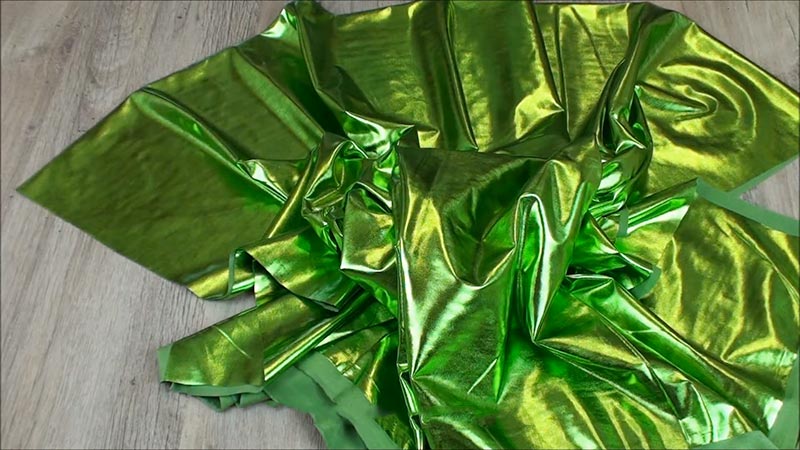
What Is Shiny Metallic Fabric?
Shiny metallic fabric is a type of textile that is woven or coated with materials to impart a reflective, metallic, or glossy finish. This fabric is often made from synthetic fibers like polyester or nylon, and it undergoes special treatments to achieve a shiny, metallic appearance.
The metallic sheen can be created through various techniques, including the use of metallic coatings, foil printing, or incorporating metallic yarns during the weaving process.
Shiny metallic fabrics are popular for creating garments, costumes, accessories, and decorative items that require a glamorous or futuristic look.
These fabrics are frequently used in fashion, particularly for eveningwear, dance costumes, and avant-garde designs, adding a touch of luxury and drama to the finished pieces.
Characteristics of Shiny Metallic Fabric
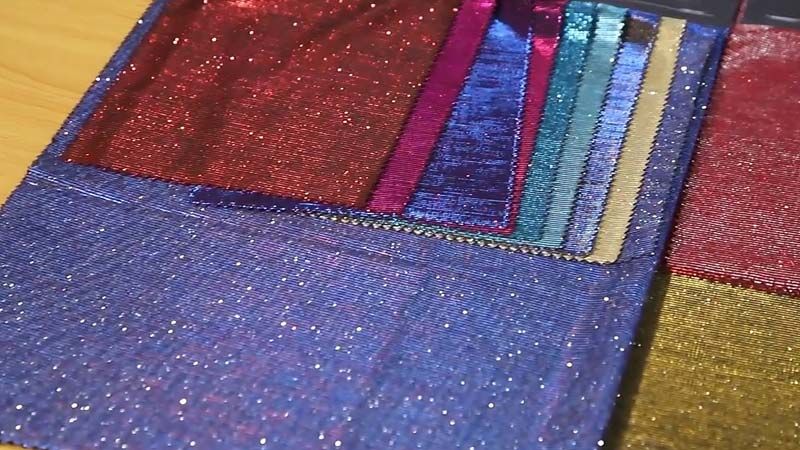
The shiny metallic fabric possesses distinctive characteristics that contribute to its unique and eye-catching appearance. Here are eight key characteristics of shiny metallic fabric:
Reflective Surface
The primary feature of the shiny metallic fabric is its reflective surface.
It has a luminous quality that catches and reflects light, creating a gleaming effect. This reflective property gives the fabric a metallic sheen.
Metallic Yarns or Coating
Shiny metallic fabric is often woven or coated with metallic yarns, threads, or coatings.
These elements are integrated into the fabric during the manufacturing process, contributing to the metallic appearance.
Smooth Texture
Shiny metallic fabrics tend to have a smooth and sleek texture. This smoothness enhances the reflective qualities of the fabric, making it visually appealing and often comfortable to the touch.
Variety of Colors
While metallic fabrics are often associated with silver and gold tones, they come in a variety of colors.
Manufacturers can apply metallic coatings to fabrics in different hues, allowing for a diverse range of metallic colors and finishes.
Glamorous Aesthetic
The glamorous aesthetic of shiny metallic fabric makes it a popular choice for fashion and decorative applications.
It is frequently used in eveningwear, costumes, and avant-garde designs to add a touch of luxury and drama.
Lightweight and Flowing
Many metallic fabrics are lightweight and have a flowing drape. This characteristic makes them suitable for creating garments with movement, such as dresses, skirts, and dance costumes.
Versatility
Shiny metallic fabric is versatile in its applications.
It can be used for a wide range of items, including clothing, accessories, home décor, and theatrical costumes. Its versatility allows for creative and diverse uses in design.
Durable and Resilient
Metallic fabrics are often durable and resilient, thanks to the synthetic fibers commonly used in their composition.
This durability makes them suitable for various applications, ensuring that the fabric maintains its shine and appearance over time.
These characteristics collectively make the shiny metallic fabric a popular choice for designers and creators looking to infuse a sense of opulence, modernity, or futuristic aesthetics into their projects.
Whether used in fashion, interior design, or artistic installations, shiny metallic fabric is valued for its ability to catch the eye and elevate the visual impact of the finished product.
What Is Shiny Metallic Fabric Called?
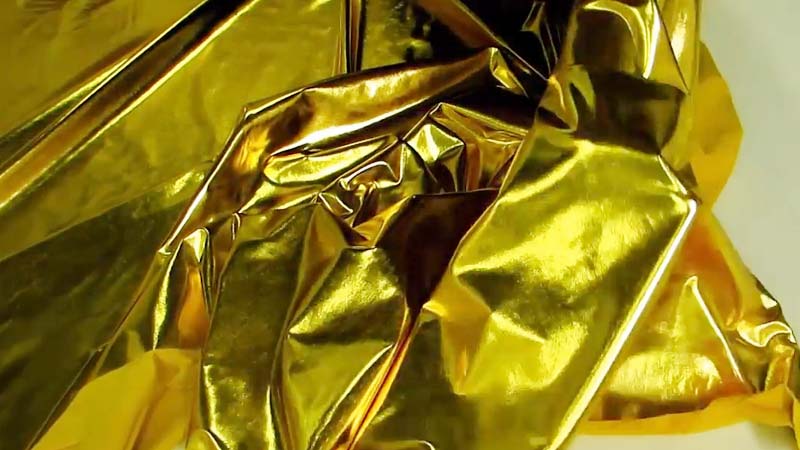
Shiny metallic fabric is often referred to by different names based on its specific characteristics and manufacturing processes. Here are some common terms used to describe or denote shiny metallic fabrics:
Lame (or Lamé)
Lamé is a type of fabric that is woven or knit with metallic yarns, creating a shimmering and reflective surface. It’s commonly used for eveningwear, costumes, and decorative applications.
Foil Fabric
Some metallic fabrics achieve their shine through a process called foil printing, where a metallic layer is applied to the fabric’s surface. This creates a reflective and metallic appearance.
Metallic Knit
Metallic knit fabrics incorporate metallic threads into the knitting process, resulting in a fabric with a sparkling and shiny finish. These fabrics are often used for garments like sweaters and dresses.
Metallic Coated Fabric
Fabrics can be coated with metallic finishes, giving them a shiny appearance. This coating is often applied to synthetic fabrics like polyester to achieve the metallic effect.
Metallic Leather
In the realm of fashion, metallic leather is a type of shiny fabric made from cotton or synthetic fiber that has been treated or coated to have a metallic sheen. It’s often used for accessories and apparel.
Sequined Fabric
While not a traditional metallic fabric, sequined fabrics are adorned with small, reflective sequins that create a shiny and glamorous effect.
Foil Jersey
Foil jersey is a stretchy knit fabric that has been treated with a metallic foil. It’s commonly used for sportswear, dance costumes, and fashion with a modern, metallic aesthetic.
These terms are often used interchangeably, and the choice of name might depend on the specific manufacturing process, the intended use of the fabric, or regional variations in terminology.
Regardless of the name, these fabrics are known for their dazzling and eye-catching appearance, making them popular in various fashion and design applications.
What Is the Metallic Fabric Called?
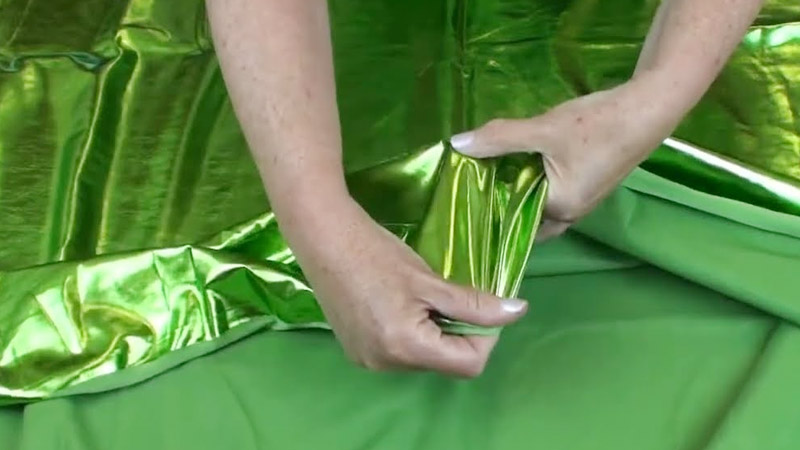
The metallic fabric is commonly referred to as “lamé.” Lamé is a luxurious textile that features a shimmering, metallic finish, typically achieved by weaving or knitting with metallic yarns or incorporating metallic fibers.
This fabric exudes opulence and is popular for creating garments with a high-fashion, glamorous, or futuristic look.
Lamé can be made from various fibers, including polyester, nylon, or a blend of synthetic materials, allowing for versatility in terms of texture and drape.
It is often used in eveningwear, dance costumes, accessories, and avant-garde fashion due to its ability to catch and reflect light, creating a striking visual effect. The term “lamé” itself has become synonymous with fabrics that exhibit a radiant and metallic sheen.
What Is a Shiny Fabric Called?
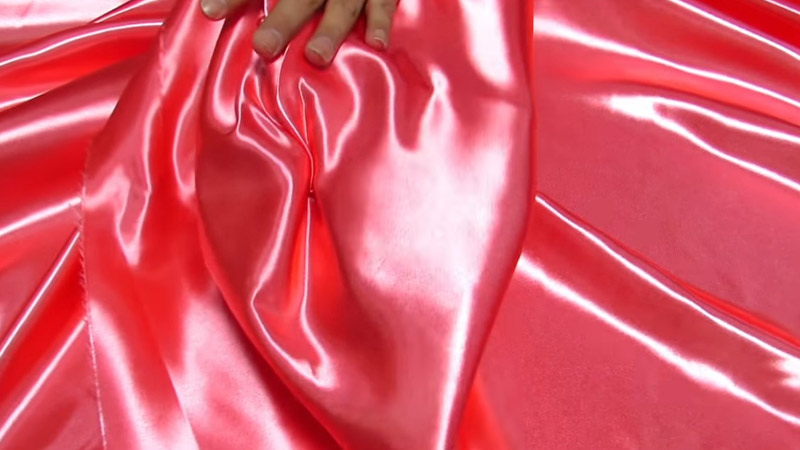
A shiny fabric made from cotton is commonly referred to by various names based on its specific characteristics and manufacturing techniques. One of the most general terms for a fabric with a shiny appearance is “lustrous fabric.”
Lustrous fabrics have a sheen or reflective quality that imparts a shiny, glossy, or gleaming look. The shininess in fabrics can be achieved through different methods such as using satin weaves, incorporating metallic threads, applying coatings, or utilizing special finishes like mercerization.
Fabrics like satin, silk, lamé, and certain synthetic materials are often associated with a shiny or lustrous finish. The choice of terminology may depend on the specific fabric type, manufacturing processes, and the intended application in fashion, upholstery, or decorative items.
What Is Shiny Cotton Called?
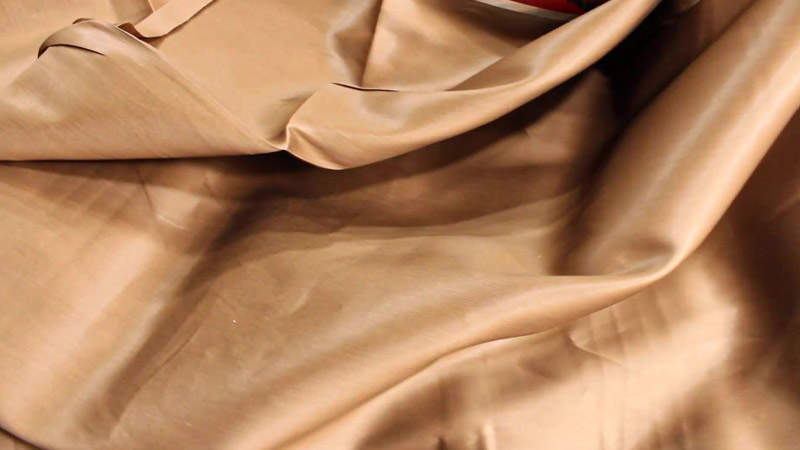
Sateen is a type of cotton that has a smooth, lustrous surface. It’s commonly used for clothing because it looks luxurious and feels soft to the touch. Sateen fabrics are also resistant to wrinkles, so they can be perfect for formal wear or special events.
They come in a variety of colors and patterns, so you can find something that perfectly matches your style. Keep in mind that sateen fabrics are more expensive than other types of cotton, but they’re worth it if you want high-quality clothes that will last longer.
Frequently Asked Questions
What is a shimmery fabric that has an excellent drape?
Silk can be a lightweight, delicate fabric that drapes well. It has a slightly shimmery appearance. Silk can be slippery and more difficult to work with. It also makes a great lining fabric.
Can you name different types of fabric?
There are three types of woven fabric: plain weave, satin weave, and twill weave. Examples of popular woven fabrics are chiffon, crepe, denim, linen, satin, and silk.
For knit fabric, think of a hand-knit scar; the yarn is formed into an interconnecting loop design, which allows it to stretch significantly.
Why is some linen shiny?
Some fabrics, such as linen, can have a shiny appearance due to the fact that they are classified as short-fiber or long-fiber materials. Short fibers are made up of smaller pieces and these look rough because their surface is tightly Joined together. Long fibers, on the other hand, are made up of longer pieces and these look smooth because their surface is loosely joined together.
What is polished cotton?
Polished cotton fabric is a type of cloth with a shiny finish, usually made from resin.
To Recap
Metallic fabric is shiny because it has been treated with a metal coating. Fabric that does not have a metallic sheen is often made from synthetic materials, which do not reflect light as brightly as true metals.
From lamé and lurex to metallic brocade and sequin fabric, each variation offers a unique sheen and texture that can elevate any fashion or décor project.
Whether you’re dressing up for a special occasion, designing the next runway sensation, or simply looking to infuse some metallic magic into your life, knowing what shiny metallic fabrics are called can open up a world of creative possibilities.
So, the next time you encounter a garment or home accessory that shimmers with metallic charm, you’ll be armed with the knowledge to appreciate its true identity and the craftsmanship that goes into making it shine.
Leave a Reply